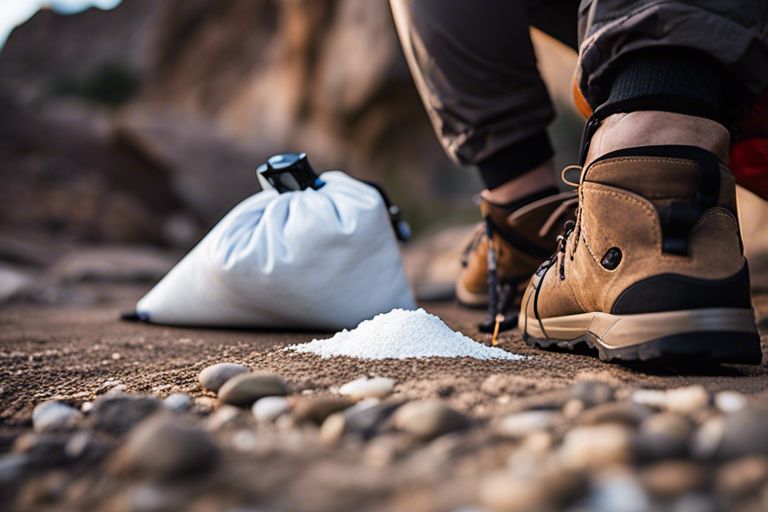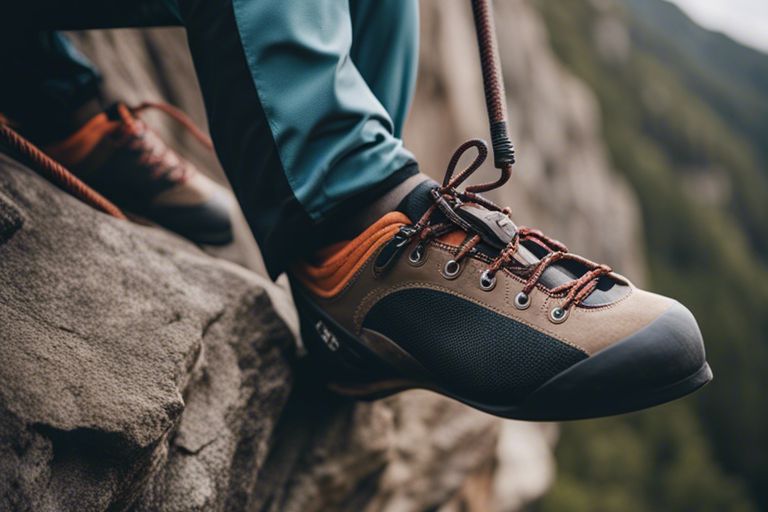There’s a fine balance to strike when filling your chalk bag for climbing or bouldering. Using the right amount of chalk not only enhances your grip but also prevents waste, which can be both costly and cumbersome. In this guide, you’ll learn how much chalk you should put in your bag based on your climbing style, the type of climbing you’re doing, and tips for maintaining an optimal chalk-to-climb ratio. With this information, you can ensure that you’re always ready for your next ascent without unnecessary distractions.
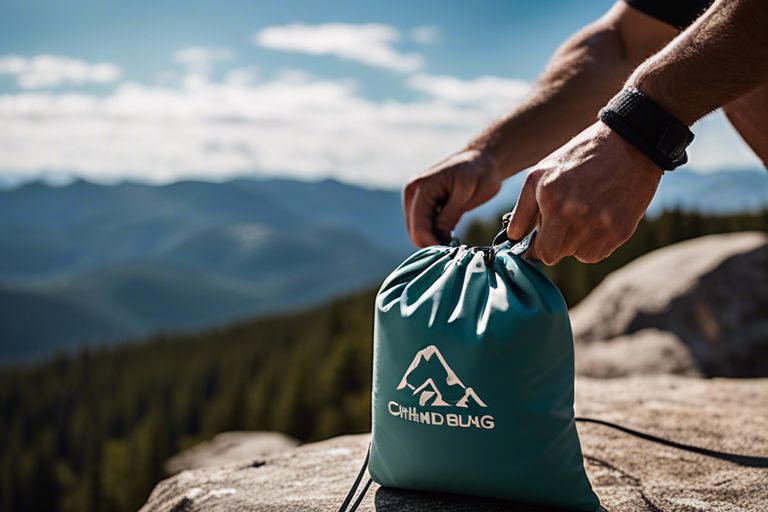
Understanding Chalk and Its Types
To truly grasp the importance of chalk in climbing and other sports, it’s vital to understand what chalk is and the various types available. Chalk, primarily made of magnesium carbonate, serves to reduce moisture and increase grip on your hands and feet, which is crucial when you’re faced with challenging climbs or feats. Here’s a brief overview of the different types of chalk:
| Type of Chalk | Description |
|---|---|
| Loose Chalk | Powdered form, easy to apply but can create a mess. |
| Chalk Balls | A mesh bag filled with chalk that dispenses it evenly. |
| Liquid Chalk | Applies like lotion, dries quickly, and reduces mess. |
| Chalk Blocks | Solid form that you can break down and transport easily. |
| Eco-Friendly Chalk | Made from natural materials to minimize environmental impact. |
The Different Types of Chalk
For climbers and athletes, the type of chalk you choose can greatly influence your performance and convenience. Loose chalk allows for easy application and is popular among many climbers. However, it can also create a mess, which may not be ideal for all climbing scenarios. Chalk balls offer a cleaner alternative as they provide a controlled release of chalk, ensuring you apply only what you need. Liquid chalk, on the other hand, can effectively reduce the amount of chalk dust created, which is beneficial for both you and the environment.
- Chalk balls avoid the mess associated with loose chalk.
- Liquid chalk dries quickly and provides a firm grip.
- Eco-friendly options are available for environmentally conscious climbers.
- Chalk blocks offer portability and ease of use.
- Choosing the right type of chalk can enhance your climbing experience.
Perceiving the nuances between chalk types helps you select the one best suited for your climbing endeavors.
| Benefits of Each Type | Considerations |
|---|---|
| Loose Chalk | Can be messy and requires careful application. |
| Chalk Balls | Limited chalk transfer can compromise grip if underused. |
| Liquid Chalk | May not provide the same immediate grip as loose chalk. |
| Chalk Blocks | Requires breaking down, which might be inconvenient. |
| Eco-Friendly Chalk | Availability might be limited compared to traditional options. |
The Purpose of Using Chalk in Climbing
On determining how much chalk to put in your chalk bag, it’s crucial to recognize the primary purpose of chalk in climbing. Chalk serves to absorb sweat, which can cause your grip to slip. By keeping your hands dry, you can maintain a firm hold on footholds and handholds, ultimately enhancing your climbing performance. Additionally, chalk can help reduce friction when climbing, allowing you to feel more secure on the rock or climbing wall.
Different climbers may have varying preferences for the amount and type of chalk they use, which could pump up your confidence when tackling challenging routes. It’s also important to note that using chalk is not just about enhancing grip; it can also serve as a mental aid, giving you the reassurance you need when facing daunting climbs.
How Chalk Affects Performance
Chalk can significantly affect your climbing performance by allowing you to maintain better grip and control. By minimizing moisture on your hands and feet, you’ll be able to ascend with more confidence and stability. Achieving a proper balance when using chalk is vital, as too much can lead to over-applying it, creating a distraction rather than a help during climbs. It’s about finding what works best for you in various conditions.
It is therefore beneficial to experiment with different types and amounts of chalk to find your sweet spot. The right chalk also helps you perform better during strenuous climbs, allowing for longer and more challenging projects without a slip. Ultimately, ensuring you have a well-stocked chalk bag that matches your climbing style is vital for maximizing your performance on the rock.
Factors Influencing Chalk Amount
Some of the key factors that influence how much chalk you should put in your chalk bag include your climbing skill level, the type of climbing you’re doing, the climatic conditions, and your personal preferences and habits. Each of these elements plays a significant role in determining the amount of chalk required to keep your grip secure and enhance your climbing performance. Here’s a quick overview of these factors:
- Climber’s Skill Level
- Type of Climbing (Sport, Bouldering, etc.)
- Climatic Conditions (Humidity, Temperature)
- Personal Preferences and Habits
The right amount of chalk can make a significant difference in your climbing experience. Understanding these factors can help you optimize your chalk usage.
Climber’s Skill Level
Any experienced climber knows that the skill level significantly affects the amount of chalk needed. Beginners might find themselves sweating more and struggling with grip, leading them to use more chalk than necessary. Conversely, seasoned climbers, often having mastered their technique and grip, will typically require less chalk, as their hands remain dry for more extended periods due to improved body control and strategy.
You should assess your climbing proficiency and adjust your chalk usage accordingly. Beginners should feel free to fill their chalk bags to be prepared for any situation, while more experienced individuals might opt for a lighter load, trusting that their technique will keep their hands dry and their chalk usage minimal. The goal is to find a balance that works best for your style.
Type of Climbing (Sport, Bouldering, etc.)
Bouldering typically requires more frequent use of chalk due to the short, intense bursts of effort involved. In contrast, sport climbing might allow you to reserve some chalk as you spend longer on routes, enabling you to conserve it for more strenuous grips. Different climbing styles will dictate how often you re-chalk your hands and the quantity you need during your climbs.
To get the best results, consider experimenting with your chalk amounts during different climbing sessions. If you’re focusing on bouldering, you might find it beneficial to keep your chalk bag fairly full for quick access throughout your climbs. In sport climbing, a lighter chalk bag will do, allowing you to keep your focus on the route itself rather than constantly needing to reapply chalk.
Climatic Conditions (Humidity, Temperature)
Humidity can greatly impact how much chalk you may need during your climbing sessions. In high humidity conditions, your hands are likely to sweat more, requiring more frequent chalk application. Conversely, in dry environments, your chalk will last longer on your hands. Here’s a table to help you understand how climatic conditions can affect your chalk needs:
Effects of Climatic Conditions on Chalk Usage
| Condition | Chalk Usage |
|---|---|
| High Humidity | Increased usage; may require frequent re-chalking |
| Low Humidity | Less usage; chalk lasts longer on hands |
Climbers often need to adjust their chalk amounts based on climatic conditions to maintain optimal grip. It is crucial to be aware of your environment during your climbing sessions and modify your chalk usage accordingly. This conscious adjustment can improve your performance and prevent slipping.
Personal Preferences and Habits
Habits also play a significant role in determining how much chalk you put in your bag. Some climbers prefer to err on the side of caution, loading their bags with more chalk than needed. Others may have developed a routine that allows them to feel confident with minimal chalk. Understanding your own habits can help you find a balance that works for your climbing style.
Plus, it’s crucial to recognize that these habits can evolve over time. As you become more experienced and knowledgeable about your body’s responses to different climbing environments, you may find yourself adjusting your chalking techniques. Experimentation is vital; observe how different chalk amounts impact your grip and confidence during climbs.
Recommended Chalk Quantities
Once again, determining how much chalk to put in your chalk bag is crucial for enhancing your climbing performance while ensuring a comfortable experience. The right amount of chalk can significantly affect your grip and, ultimately, your success on the wall. Remember that the quantities you use may vary based on your climbing style, the type of routes you’re tackling, and personal preferences.
Beginners: Starting Small
An excellent starting point for beginners is to use a small amount of chalk, typically around 30-50 grams. This modest quantity allows you to familiarize yourself with it without overwhelming your climbing gear. As a beginner, you may not yet fully appreciate the need for chalk, and starting small can help you understand its benefits without wasting any.
As you gain more confidence and experience in climbing, you’ll likely develop a sense of how much chalk feels comfortable for you. At this stage, you might want to experiment with slightly larger quantities while observing how it impacts your grip and overall climbing performance.
Intermediate Climbers: Finding the Balance
An intermediate climber should aim for around 50-75 grams of chalk in their bag. This quantity strikes a balance between ensuring you have enough chalk to maintain a solid grip while not weighing you down or leaving a mess behind. You’ll start to understand your personal needs during climbs at this stage, allowing you to adjust the chalk’s quantity based on the humidity and the type of climbing you’re doing.
As you progress, consider the specific demands of your climbs and the environments you often find yourself in. The key is to find that perfect ratio that helps boost your performance without causing unnecessary fuss regarding chalk application.
Beginners will often find that their chalk use fluctuates as they learn the nuances of climbing. Tracking how much chalk you require during different climbs will help you gauge your personal needs. Paying attention to the routes you tackle and your comfort level can significantly influence your chalk habits as you move toward intermediate and advanced levels.
Advanced Climbers: Maximizing Grip
Maximizing grip as an advanced climber involves a chalk quantity of about 75-100 grams. This amount allows you to maintain a chalked surface on your hands without applying excessive product on each route. Advanced climbing often features more challenging holds and dynamic movements, making a sufficient chalk supply vital for maintaining grip.
- Use a larger chalk quantity on strenuous or high-intensity climbs.
- Consider environmental factors like humidity, which may affect chalk performance.
- Experiment with chalk application techniques to find what works best for your climbing style.
| Chalk Quantity | Climber Level |
|---|---|
| 30-50 grams | Beginners |
| 50-75 grams | Intermediate |
| 75-100 grams | Advanced |
This advanced usage of chalk can enhance your grip, ensuring you perform well on challenging routes. Finding the right balance for chalk quantity while ensuring you remain comfortable is key to maximizing your climbing experience.
- Consider investing in a reusable chalk ball for precise chalk application.
- Keep your chalk bag easily accessible for quick touch-ups during climbs.
- Evaluate your chalk usage post-climb to adjust future quantities.
| Advanced Chalk Tips | Description |
|---|---|
| Chalk ball | Offers controlled chalk application and maintains cleanliness. |
| Frequent touch-ups | Helps avoid the build-up of moisture on holds. |
Comparing Liquid Chalk vs. Loose Chalk
Liquid chalk provides a unique alternative to traditional loose chalk. Offering a more controlled application, liquid chalk often contains a mixture of chalk and alcohol, which evaporates quickly, leaving behind a chalky residue on your hands. This can significantly reduce the amount of loose chalk your bag requires while ensuring you retain a good grip on the holds.
| Liquid Chalk Benefits | Loose Chalk Benefits |
|---|---|
| Long-lasting and effective grip | Quick application and easy to reapply |
| Minimizes chalk dust | Highly customizable application quantity |
Liquid chalk may also appeal to climbers looking for a cleaner, dust-free experience. Many climbers find that using liquid chalk first and then topping up with loose chalk enhances grip during prolonged climbing sessions. The combined approach can provide additional security, depending on your climbing style and the conditions you’re facing.
| Chalk Comparison | Key Traits |
|---|---|
| Liquid Chalk | Quick-drying, minimal dust, and better grip retention |
| Loose Chalk | Easy to manage, higher availability, and customized quantities |
Finding your preferred choice between liquid and loose chalk will require some experimentation. Try using both methods and see how they feel during climbs. Balancing the two can help you find optimal performance based on your needs.
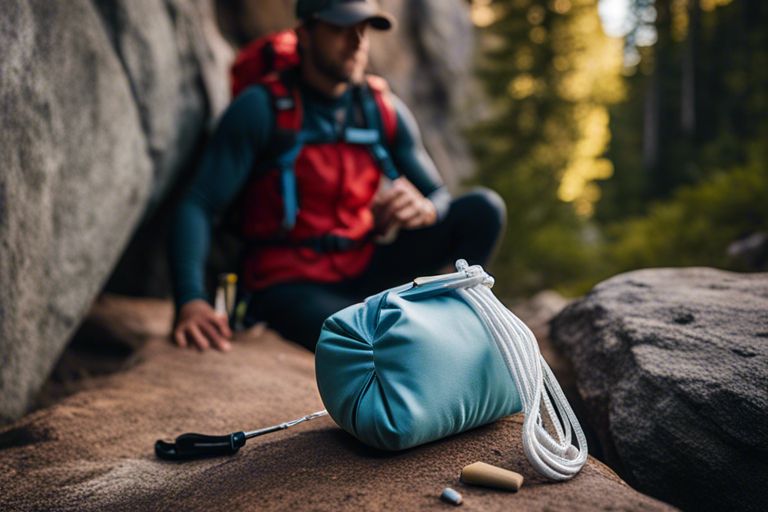
Techniques for Filling a Chalk Bag
Not every climber knows the best practices for filling a chalk bag efficiently. Properly filling your chalk bag can significantly impact your climbing performance, ensuring that you have enough chalk on your hands when you need it without creating unnecessary mess or waste. In this section, we will discuss the techniques that will help you optimize your chalk bag usage.
How to Select the Right Chalk Bag
One of the first steps in using a chalk bag effectively is to make sure you’ve chosen the right one for your needs. When opting for a chalk bag, consider factors such as size, opening width, and the ease with which you can access your chalk. A larger chalk bag may hold more chalk but can be cumbersome when climbing, while a smaller bag might require more frequent refilling but can be less obtrusive.
Additionally, think about the material of the chalk bag and how it retains chalk. Some materials will keep chalk in place better than others, reducing the risk of chalk clouds when you dip your hands. By selecting the right chalk bag for your climbing style and preferences, you’ll set yourself up for success on the rock face.
Tips for Filling the Bag Properly
Chalk should be added to your bag with care. You want to fill your chalk bag to an optimal level without cramming it too full or leaving it nearly empty. A well-filled chalk bag allows for quick and easy access to chalk while you’re climbing. To ensure you’re filling your chalk bag correctly, follow these tips:
- Start with a small amount of chalk and gradually increase it until the bag feels right for you.
- Gently shake or tap the bag to settle the chalk evenly before use.
- Avoid tightly packing the chalk, as this can make it difficult to retrieve.
This method will help you find the right balance for your needs while keeping your chalk bag functional and easy to use.
- Maintain a consistent refill habit to avoid running out when you need it most.
- Be mindful of the type of chalk you use, as some may be finer or coarser than others, impacting how much you should put in the bag.
- Keep your bag clean to minimize waste and ensure you maximize the amount of chalk you can use throughout your climbing sessions.
This will help maintain the effectiveness of your chalk application while minimizing waste.
Avoiding Overfilling or Underfilling
The key to avoiding overfilling or underfilling lies in understanding your personal chalk usage. Overfilling can create a mess and make it difficult to access the chalk when you need it, while underfilling can lead to interruptions during your climbs as you try to scrape together enough chalk. Striking a balance is imperative.
Investing time to figure out your preferences and usage patterns will pay off in smoother climbs and added efficiency. A well-filled chalk bag will not only improve your grip but also contribute to your confidence as you ascend, allowing you to focus on your climbing rather than on your gear.
A careful approach to filling your chalk bag can make a significant difference. Once you establish your preferred ambient chalk level, sticking to that rhythm will make preparation for your climbs far more relaxed. Rely on observation and adjustment to continually hone in on your ideal chalk bag fill.
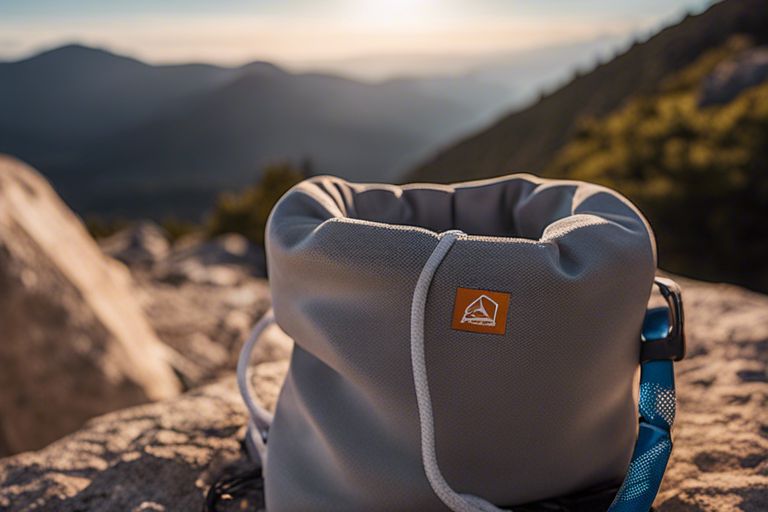
Maintenance of Chalk and Chalk Bags
Now that you know how much chalk to use in your chalk bag, it’s important to consider how to maintain both your chalk and your chalk bag. Proper upkeep will not only help in providing a better climbing experience but will also extend the lifespan of your gear. By paying attention to cleaning and storage, you ensure that your chalk and chalk bag stay in optimum condition for your climbing adventures.
Cleaning Your Chalk Bag
On a regular basis, you should check your chalk bag for any debris, dust, or old chalk that may affect its performance. To clean your chalk bag, first, empty it completely. Use a soft brush or a damp cloth to wipe away any residue from the inside and outside of the bag. If your chalk bag is machine washable, follow the manufacturer’s instructions for cleaning. Otherwise, a simple hand wash with mild soap and water should suffice.
On top of that, make sure to air dry your chalk bag after cleaning it. Avoid using a dryer, as heat can damage the fabric and any internal lining. Keeping your bag clean will not only maintain its efficacy but will also help in preventing any unwanted odors from accumulating over time.
How to Store Chalk Properly
Any climbing enthusiast knows that proper storage of your chalk is crucial for maintaining its quality. First, ensure that your chalk is stored in a cool, dry place away from moisture, which can cause it to clump and lose its effectiveness. Consider using an airtight container to keep your chalk fresh. This is especially important if you live in a humid area or if you won’t be using your chalk for an extended period of time.
Any extra steps you take to manage your chalk storage can significantly impact its performance. Avoid storing your chalk in direct sunlight or near heat sources, as extreme temperatures can degrade its quality. After each climbing session, give your chalk a quick shake or stir to ensure that it stays evenly distributed, preventing clumping in the bag.
Cleaning your chalk bag and storing your chalk properly will prolong their life and ensure they remain functional. Developing these simple habits will enhance your climbing experience and keep your equipment in the best possible condition.
Signs It’s Time to Replace Your Chalk
To determine when it’s time to replace your chalk, pay attention to its texture and performance. If you find that your chalk is clumping, has become excessively hard, or does not dry your hands effectively, it is likely reaching the end of its life. Regularly assess the amount of chalk you have left in your bag; when your chalk is worn down significantly, purchasing a new bag may be in order.
To ensure you’re always prepared for your next climbing session, consider creating a schedule to check your chalk’s condition regularly. Depending on how frequently you climb and how hard you push your gear, you may find yourself needing to replace your chalk more often than you expect.
Chalk plays a vital role in your climbing performance, as the right consistency and freshness will enhance your grip and confidence while scaling heights. Don’t overlook the importance of keeping track of your chalk’s condition to guarantee peak performance on your climbs.
Common Mistakes with Chalk Usage
Despite the importance of proper chalk usage in climbing, many climbers still make common mistakes that can hinder their performance. By being aware of these pitfalls, you can optimize your chalking routine and enhance your climbing experience.
Using Too Much Chalk
An overly generous application of chalk can lead to challenges rather than improvements in your climbing. While the goal is to keep your hands dry and improve your grip, applying too much chalk can actually create a messy situation. Excess chalk can clump together and inhibit your contact with the rock or climbing surface, leading to diminished friction and potential slips.
Additionally, excessive chalk use can lead to an unnecessary accumulation of powder on your climbing gear, holds, and even your clothes. This can be not only distracting but also wasteful. A light dusting is usually sufficient to provide the grip you need without compromising your performance. Striking the right balance is important for an effective chalk routine.
Neglecting to Reapply During Climbs
Neglecting to reapply chalk during your climbs can lead to decreased performance, especially on longer routes or boulders. Your hands can sweat, and chalk can wear off, making it necessary to refresh your grip throughout the ascent. Failing to do so can result in slips and a loss of confidence, which can ultimately affect your climbing ability.
During climbs, creating a habit of checking your grip and applying chalk when necessary can help maintain your performance. Make it a part of your routine to chalk up before critical holds, ensuring that you remain comfortable and confident as you tackle challenging routes.
Mixing Different Types of Chalk
The blending of different chalk types can lead to unpredictable outcomes that might not enhance your grip. Each brand or type of chalk has its own formulation, and combining them may create a blend that doesn’t perform effectively on the rock. This can lead to confusion about which chalk best meets your needs, potentially resulting in compromised performance.
| Common Mistakes | Consequences |
| Using Too Much Chalk | Inhibits grip, creates mess |
| Neglecting to Reapply | Decreased confidence and performance |
| Mixing Different Chalks | Unpredictable grip results |
| Ignoring Environmental Conditions | Potential slips due to wet holds |
| Not Experimenting | Limited awareness of optimal performance |
To further understand the impact of mixing different types of chalk, consider that each type is designed with specific properties aimed at enhancing performance. Using various types can dilute those advantages and lead to an undesirable grip. The takeaway here is to stick to one reliable chalk brand or type that you know works for you, especially in varying conditions.
- Stick to chalk that you trust and have tested in your climbing routine.
- Assess changes in chalk effects based on climbing conditions.
- Do not mix brands casually; always keep track of performance changes.
- Check for compatibility of different chalk types before using them together.
- Assume that combining chalks may yield unpredictable results.
To sum up the importance of using the right chalk effectively, be cautious of the types you apply on the wall. Understand that each specific variety plays a distinct role in how they help you cling to holds. By closely monitoring your chalk usage, you can improve your handling and experience on the rock.
- Evaluate what type of chalk gives you the best grip.
- Be mindful of the quantity you apply; less can often be more.
- Pay attention to how the chalk interacts with sweat and moisture.
- Establish a regular routine of chalk checks during climbs.
- Assume that consistency in your chalking method will enhance your performance.
| Chalk Evaluation | Consideration Factors |
| Texture | Grip enhancement |
| Moisture Resistance | Consistency during climbs |
| Fine vs. Chunky | Application style |
| Brand Trust | Performance feedback |
| Compatibility | Mixing effects |
By focusing on these common mistakes and how to avoid them, you can ensure that your climbing experience is as effective and enjoyable as possible. Proper chalk usage can be a game-changer in your climbing journey.
Additional Considerations
All climbers and gym-goers should take a moment to consider factors beyond just the amount of chalk to put in your chalk bag. While it may seem straightforward, various elements can impact your overall experience, such as the environmental implications of your chalk choice and alternatives that promote sustainability while still providing adequate grip.
Environmental Impact of Chalk
On many occasions, you might not think about the environmental repercussions associated with chalk production and usage. Traditional climbing chalk is typically made from magnesium carbonate, which, while effective, is derived from mineral extraction processes that can be harmful to our ecosystems. Running a chalk bag full can lead to your chalk dust settling onto local flora and fauna, which can disrupt their natural habitat. Even though this may seem minimal, every little bit matters when considering your outdoor impact.
On top of that, the packaging and transportation of chalk also contribute to carbon footprints. Many companies are making strides to reduce waste, but understanding the broader implications of your chalk choice can help you make more informed decisions. Opting for eco-friendly products ensures that you are doing your part in preserving the environment while enjoying your climbing activities.
Alternatives to Traditional Chalk
To explore your options beyond traditional chalk can empower you to make sustainable choices that also meet your climbing needs. There are various chalk alternatives available on the market today, including eco-friendly compounds made from natural substances such as clay or charcoal. These options offer similar grip enhancement without the environmental drawbacks of standard chalk. Additionally, some companies produce chalk infused with skin-conditioning agents, which can help keep your hands moisturized while you climb.
To further reinforce your commitment to environmentally friendly practices, consider options such as chalk balls or refillable chalk bags that minimize mess and waste. Using chalk balls can help control the amount of chalk released, which is beneficial in preserving the surroundings you climb in.
Innovations in Chalk Technology
Technology in the climbing world is continuously evolving, leading to innovations in chalk production that prioritize both performance and sustainability. Various brands are experimenting with formulations that enhance grip while using more eco-conscious ingredients, revolutionizing the way you think about your climbing experience. Products that integrate advanced moisture-wicking properties offer even better performance, allowing you to focus on your climb without worrying about reapplication.
Technology has also led to improved packaging solutions, ensuring that products are not only effective but also easier to carry. This innovation reduces waste and enhances the overall user experience, allowing you to optimize the amount of chalk you use without compromising on quality. By staying informed about the latest developments, you can choose products that align with your climbing goals and your values.
It is worth noting that as the climbing community becomes more aware of ecological issues, the trends in chalk technology are likely to shift towards even more sustainable practices, providing you with an ever-expanding range of options to improve your climbing experience while being kind to the planet.
Conclusion
Drawing together the insights on how much chalk to put in your chalk bag, it’s vital to find the right balance that works for you. The ideal amount typically falls between a quarter to half of your chalk bag’s capacity, allowing for easy access without overwhelming your hands with excess chalk. Pay attention to your specific needs based on the type of climbing or activity you engage in; different environments might require adjustments in how much chalk you carry. Do not forget, having too much chalk can lead to unnecessary mess and hinder your grip, while having too little might compromise your performance.
In brief, your chalk usage should evolve with your climbing journey, adaptable to your preferences and the challenges you face. Make sure to monitor your chalk levels frequently, adjusting the amount as necessary to optimize your performance and enjoyment. By taking these factors into account, you can ensure that your chalk bag serves you well, keeping your hands dry and your focus sharp as you tackle each ascent. Happy climbing!

